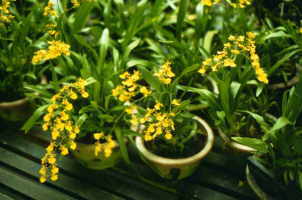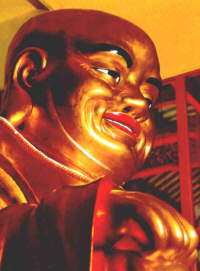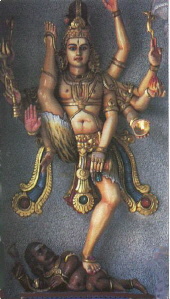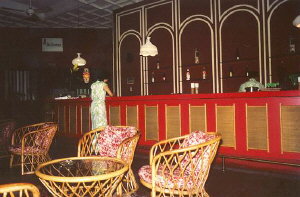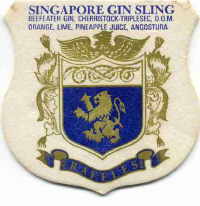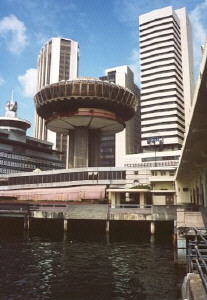Today's Singapore is a fine clean city
|
The spot near the place where Sir Stamford Raffles (see monument) of the British East India Company first set foot on the island in 1819 and where he concluded a treaty for Britain to establish a trading post at the mouth of Singapore River. At that time "Singapura" was an obscure swampy fishing village. The building in the background is the Victoria Theatre and Hall with its clock tower. It is remarkable that Sir Stamford Raffles spent only one year in Singapore.
|
|
|
Singapore's famous orchid "Golden Shower" at Singapore Botanic Gardens. |
|
|
Laughing Buddha (photo left) and the goddess Kali. Singapore has an amazing diversity of temples and mosques because of its various races and ethnic cultures. Goddess Kali is at the Sri Veeramakaliamman Temple. |
|
|
|
The famous and original Singapore Gin Sling receipt of the legendary old Raffles Hotel for romanticists, old-timers and Somerset Maughamers. The picture left shows part of the famous long "Red Bar" (the longest in Asia) at old Raffles Hotel. |
|
According to Malay history a Palembang prince, Sang Nila Utama, after being driven ashore during a storm and seeing some strange animal, founded a city and called it Singapura, the Lion City, however, there have never been lions on the little island but there was no shortage of tigers. Singa in Malay means lion. When immigrants cleared the thick jungle on the island in the 1850s, as many as 400 persons were killed by tigers... The photo shows the "Mirlion" statue at Mirlion Park, a half-lion, half a fish that has become a symbol of modern Singapore. The name is not derived from "mermaid" rather from "miracle". |
|
|
A bridge crossing Singapore River near the confluence of Singapore River and Marina Bay close to Mirlion Park. The old building facing the other side of the bridge was (or still is) the G.P.O. (General Post Office) built by the British. Far right in the background you can see the Mirlion statue. In most other respects , almost all signs of the colonial past are gone, replaced by high-rise buildings.
|
|
|
Clifford Pier. From here you can catch ferries to Batam and Bintang islands or negotiate a price of a bumbout or sampang trip to other sites. Our family escaped British internment from this pier in September 1939 with a motor launch to a Dutch ship (M.S. Both) sailing to Batavia ( today's Jakarta) and leaving behind all our property in Singapore. |
|
|
Islands
in the sun, en route between Singapore and Jakarta. Does anybody know
the name of the left island?
|
Read the latest news about Singapore in The Straits Times INTERACTIVE
Past Singapore
This post card in my collection of postage specimens is one of the oldest I have. It shows a Singapore Suburban Police Station in the 19th century. The particularities of this card are three postmarks on the reverse of the card. It was used as German Military Post and written on 2nd September 1900 by a German officer en route to China (Boxer's Revolt in China). One postmark notes "S.B. OSTAS. EXPED. Prov.-Kolonne 1", the second postmark "?? Deutsche Marine Schiffspost No. ??" (rather illegible), the third is the date the mail was received in Halle / Germany " 1st October 1900".
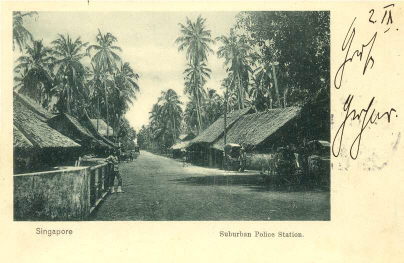
Although today's Singapore being a very charming metropolis and no longer has much to do with the former British colonial port and greatest naval base of the British empire east of Suez, I wish to recall for the younger as a contemporary witness that the German community in Singapore ever since the first World War (1914 -18) was ostracized by the British colonial administration. I spent several years in Singapore and as a schoolboy in 1937 remember having seen a signboard at the entrance of one of the well established English Clubs reading " No admittance for Dogs and Germans". Not all Clubs followed this discrimination but war harassing against Germany was in process here already two years before World War II. Those clubs at that time also selected their members by colour of the hand palms and fingernail checks. Most of the British "subordinates" of the Crown Colony were excluded. At that time in Singapore I also attended the laying of the corner-stone of the German Club which later became the Goodwood Hotel.
The Japanese occupation of Singapore early 1942 brought an end to an extended period of British colonialism of Straits Settlements (Malayan Peninsula) since 1826. The British Forces were confronted by a jungle-trained Japanese Army which arrived from the "backdoor" (mainland) on bicycles across the narrow Straits of Johore foiling the bunkers and stationary big guns pointing out to the sea. What a great mistake to expect an enemy from the sea only. The British returned in September 1945, however, the Fall of Singapore was the beginning of liberation from colonialism as they have not always been the nice boys "Trooping the Colour" only.
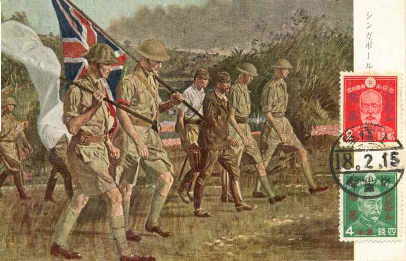
1943 Japanese Postal Card with 1942 special series stamps commemorating the Fall of Singapore. The stamps have an overprint "Shonanto". The Japanese renamed Singapore "Shonan" meaning something like "Light of the Sun" or "City of the South".
For further information about Singapore's past I recommend to visit the website
http://ourstory.asia1.com.sg/welcome.html
and habe a look at the "War Years Page". Turn back the clock to re-live history. The website covers various topics. Very interesting are the "Windows of the past".

